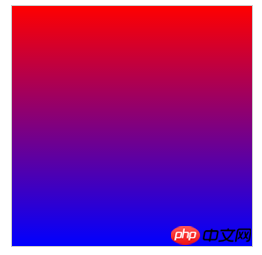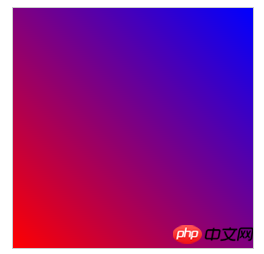Use CSS3 to implement background color gradient
This articleIntroductionUsing CSS3 to achieve background color gradient
CSS gradient color concept:
CSS gradient color (Gradients) allows us to use a color gradient The effect modifies a space - transitioning from one color to another - filling the space. There are two forms of gradient colors: linear (linear gradient) and radial (circular gradient). It is obvious that CSS gradient color (Gradients) technology produces a visual pattern effect, and achieving this visual effect is very simple and can be achieved through simple programming. CSS gradients were introduced very early in CSS3, but the promotion of this technology took a long time.
Basic syntax of CSS gradient technology:
Unified code format
background-image: linear-gradient(<point> || <angle>,]? <stop>, <stop> [, <stop>]*)
The first parameter is the gradient starting point or angle. The second parameter is a color stop. At least two colors are required (starting point and end point), and you can add any color to increase the richness of the color gradient. The definition of the color stop point can be a color, or a color plus a percentage:
/* color-stop(percentage/amount, color) */ color-stop(0.20, red)
The following code Basically covers all situations of top-down color gradients:
{ /* 底色 */
background-color: #063053;
/* chrome 2+, safari 4+; multiple color stops */
background-image:-webkit-gradient(linear, left bottom, left top, color-stop(0.32, #063053),
color-stop(0.66, #395873), color-stop(0.83, #5c7c99));
/* chrome 10+, safari 5.1+ */
background-image: -webkit-linear-gradient(#063053, #395873, #5c7c99);
/* firefox; multiple color stops */
background-image: -moz-linear-gradient(top,#063053, #395873, #5c7c99);
/* ie 6+ */
filter: progid:DXImageTransform.Microsoft.gradient(startColorstr='#063053', endColorstr='#395873');
/* ie8 + */
-ms-filter: "progid:DXImageTransform.Microsoft.gradient(startColorstr='#063053', endColorstr='#395873')";
/* ie10 */
background-image: -ms-linear-gradient(#063053, #395873, #5c7c99);
/* opera 11.1 */
background-image: -o-linear-gradient(#063053, #395873, #5c7c99);
/* 标准写法 */
background-image: linear-gradient(#063053, #395873, #5c7c99);
}CSS gradient color (Gradients) technology also supports gradient directions with angles, such as 45-degree angle gradient:
/* fallback */ background-color:#063053; /* chrome 2+, safari 4+; multiple color stops */ background-image:-webkit-gradient(linear, left bottom, right top, color-stop(0.32, #063053), color-s top(0.66, #395873), color-stop(0.83, #5c7c99)); /* chrome 10+, safari 5.1+ */ background-image:-webkit-linear-gradient(45deg, #063053, #395873, #5c7c99); /* firefox; multiple color stops */ background-image:-moz-linear-gradient(45deg, #063053, #395873, #5c7c99); /* ie10 */ background-image: -ms-linear-gradient(45deg, #063053 0%, #395873 100%); /* opera 11.1 */ background-image: -o-linear-gradient(45deg, #063053, #395873); /* The "standard" */ background-image: linear-gradient(45deg, #063053, #395873); }
CSS color gradient (Gradients) technology is valuable, but sometimes difficult to implement. Sometimes you've already implemented the gradient you want, and browser support can become an issue. Here are some suggestions for using CSS color gradients (Gradients):
Want your CSS color gradients (Gradients) to show a certain degree of transparency? Use rgba colors.
Use the background color as the bottom to prevent you from accidentally not having any color when the browser does not support it.
Firefox and Google Chrome both support repeating-linear-gradient and repeating-radial-gradient. The usage is:
background-image: -moz-repeating-linear-gradient(top left -45deg, green, red 5px, white 5px, #ccc 10px); background-image: -webkit-repeating-linear-gradient(-45deg, green, red 5px, white 5px, #ccc 10px);
Effect:
Basic color linear gradient, top to bottom

Basic color linear gradient, 45 degree angle (Chrome, Safari, Firefox, IE10, Opera)

The above is the detailed content of Use CSS3 to implement background color gradient. For more information, please follow other related articles on the PHP Chinese website!

Hot AI Tools

Undresser.AI Undress
AI-powered app for creating realistic nude photos

AI Clothes Remover
Online AI tool for removing clothes from photos.

Undress AI Tool
Undress images for free

Clothoff.io
AI clothes remover

AI Hentai Generator
Generate AI Hentai for free.

Hot Article

Hot Tools

Notepad++7.3.1
Easy-to-use and free code editor

SublimeText3 Chinese version
Chinese version, very easy to use

Zend Studio 13.0.1
Powerful PHP integrated development environment

Dreamweaver CS6
Visual web development tools

SublimeText3 Mac version
God-level code editing software (SublimeText3)

Hot Topics
 1371
1371
 52
52
 How to achieve wave effect with pure CSS3? (code example)
Jun 28, 2022 pm 01:39 PM
How to achieve wave effect with pure CSS3? (code example)
Jun 28, 2022 pm 01:39 PM
How to achieve wave effect with pure CSS3? This article will introduce to you how to use SVG and CSS animation to create wave effects. I hope it will be helpful to you!
 Use CSS skillfully to realize various strange-shaped buttons (with code)
Jul 19, 2022 am 11:28 AM
Use CSS skillfully to realize various strange-shaped buttons (with code)
Jul 19, 2022 am 11:28 AM
This article will show you how to use CSS to easily realize various weird-shaped buttons that appear frequently. I hope it will be helpful to you!
 How to hide elements in css without taking up space
Jun 01, 2022 pm 07:15 PM
How to hide elements in css without taking up space
Jun 01, 2022 pm 07:15 PM
Two methods: 1. Using the display attribute, just add the "display:none;" style to the element. 2. Use the position and top attributes to set the absolute positioning of the element to hide the element. Just add the "position:absolute;top:-9999px;" style to the element.
 How to implement lace borders in css3
Sep 16, 2022 pm 07:11 PM
How to implement lace borders in css3
Sep 16, 2022 pm 07:11 PM
In CSS, you can use the border-image attribute to achieve a lace border. The border-image attribute can use images to create borders, that is, add a background image to the border. You only need to specify the background image as a lace style; the syntax "border-image: url (image path) offsets the image border width inward. Whether outset is repeated;".
 It turns out that text carousel and image carousel can also be realized using pure CSS!
Jun 10, 2022 pm 01:00 PM
It turns out that text carousel and image carousel can also be realized using pure CSS!
Jun 10, 2022 pm 01:00 PM
How to create text carousel and image carousel? The first thing everyone thinks of is whether to use js. In fact, text carousel and image carousel can also be realized using pure CSS. Let’s take a look at the implementation method. I hope it will be helpful to everyone!
 How to enlarge the image by clicking the mouse in css3
Apr 25, 2022 pm 04:52 PM
How to enlarge the image by clicking the mouse in css3
Apr 25, 2022 pm 04:52 PM
Implementation method: 1. Use the ":active" selector to select the state of the mouse click on the picture; 2. Use the transform attribute and scale() function to achieve the picture magnification effect, the syntax "img:active {transform: scale(x-axis magnification, y Axis magnification);}".
 css3 what is adaptive layout
Jun 02, 2022 pm 12:05 PM
css3 what is adaptive layout
Jun 02, 2022 pm 12:05 PM
Adaptive layout, also known as "responsive layout", refers to a web page layout that can automatically recognize the screen width and make corresponding adjustments; such a web page can be compatible with multiple different terminals instead of making a specific version for each terminal. . Adaptive layout was born to solve the problem of mobile web browsing, and can provide a good user experience for users using different terminals.
 Does css3 animation effect have deformation?
Apr 28, 2022 pm 02:20 PM
Does css3 animation effect have deformation?
Apr 28, 2022 pm 02:20 PM
The animation effect in css3 has deformation; you can use "animation: animation attribute @keyframes ..{..{transform: transformation attribute}}" to achieve deformation animation effect. The animation attribute is used to set the animation style, and the transform attribute is used to set the deformation style. .




